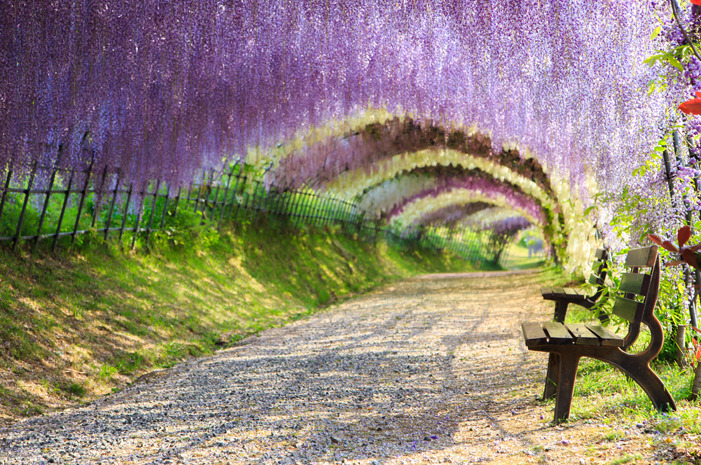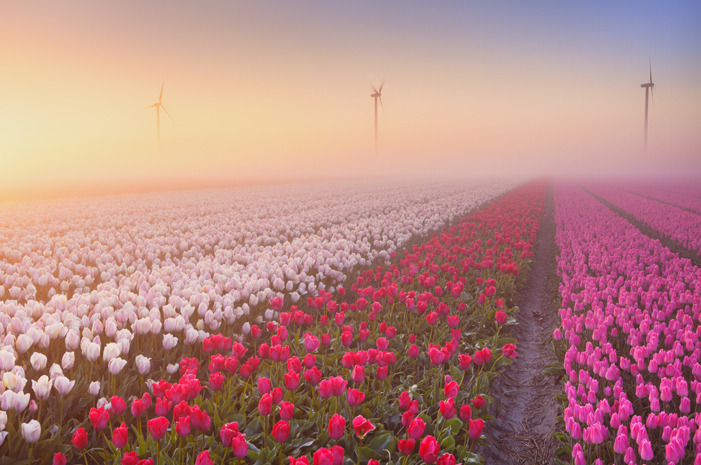Mind-Blowing Colors Found In Nature
Mind-Blowing Colors Found in Nature
If you find yourself in awe over rainbows, the natural colors you are about to see going to blow your mind.
Different hues have a way of changing emotions. For instance, in ancient times red was used to stimulate the mind and increases circulation, yellow was thought to stimulates the nerves, orange was used to increase energy levels, blue was believed to treat pain, and indigo was thought to alleviate skin problems (abouthealth).
The benefits of spending time in nature are endless. "Researchers are amassing a body of evidence, proving what we all know to be true: nature is good for us and has both long and short term mental and physical health benefits," according to the American Society of Landscape Architects.
Recent studies have shown that merely a walk in the park can calm the mind while changing the way the brain works in ways that improve mental health.
From flowers to landscapes and underwater displays these colors in nature are found all over the world. Mother Nature was at her best when she created these incredible displays and now we want to share them with you.
1. Antelope Canyon, Arizona
Antelope Canyon is one of the most photographed canyons in the American Southwest. It is made up of two canyons. . The upper is approximately 4,000 feet in elevation. When the sunlight shines in the colors of the canyon, they appear to vibrate off of the walls. The canyon looks red, gold and orange.
2. Coral Reef, Indonesia
The vibrant colors of the coral reefs in Indonesia will blow you away. The water is crystal clear which allows the reefs to expose their psychedelic swirl of colors. These colors are composed of bright reds, yellows, greens and blues.
3. Kawachi Fuji Gardens, Japan
Prepare to be mesmerized as you enter the Kawachi Fuji Gardens, majestical pastel-colored tunnel full of approximately 150 Wisteria plants. As you walk the pathway, breathe in the fresh flowery scent and take in the surrounding violet, blue, white and pink flowers. Tip: Visit in the beginning of May when the flowers are in full bloom.
4. Lavender Fields, France
The photo definitely speaks for itself. The Lavender Fields are absolutely stunning. Enjoy a tranquil walk through the fields, take in the relaxing scent, and embrace the vivid colors surrounding you.
5. Zhangye Danxia, Southwest China
Zhangye Sanxia is located in the Zhangye Danxia National Geological Park. It has been voted one of the most beautiful landforms in China and for a good reason. The rocks and cliffs come in a variety of formations — smooth, sharp, vibrant and extremely tall. While the colorful rocks and rainbow ridges are sure to blow you away.
6. Aurora Borealis
The Aurora Borealis is also known as the Northern Lights. It's a spectacular display of colored lights that light up the night sky. The best time of the year to see the lights is between September and March. But hurry up because according to research after next year the lights will be more difficult to see. The best places to see the lights are in Norway, Alaska, Iceland, Sweden and Finland.
7. Red Seabeach, China
Red Seabeach is the biggest wetland in the world featuring the red plant, Suaedla salsa. For the best viewing, visit Red Seabeach in autumn when the weeds are flourishing and the landscape is bright red.
8. Petrified Wood, Petrified Forest National park, Arizona
Petrified wood can be found in Petrified Forest National Park. It's the product of trees transitioning into stone. According to the National Park Service, "each piece is like a giant crystal, often sparkling in the sunlight as if covered by glitter." The rainbow of colors is produced by impurities in the quartz, such as iron, carbon, and manganese.
9. Light Pillars, Finland
Light pillars, sometimes also known as sun pillars, are long vertical shafts that have formed from a bright light source. They reflect off the surfaces of thousands of falling ice crystals in high clouds. From afar, they may look like beautiful poles coming down from the sky. They usually form when the sun is low before sunset or sunrise, depending where you're in the east or west.
10. Great Barrier Reef, Australia
The Great Barrier Reef is Australia's natural wonder. This famous place is one of the seven wonders of the natural world. It is larger than the Great Wall of China and the only living thing on earth visible from space. The lavishness of the reef's marine life, which comprises of over 3,000 individual reef systems, coral cays, tropical islands and stunning golden beaches, make for breathtaking views.
Valley of Flowers National Park, India
The Valley of Flowers is a must-see if you're ever visiting India. The surge of aromas from more than 300 alpine flowers will take your breath away. It's open from June until October; it's usually covered in snow the rest of the year. As you look at the horizon, you will see bright colorful carpet with refreshing mountainous snowflakes in the background. They valley is about 55 miles long.
12. Shark Bay, Australia
Shark Bay in the Gascoyne region of Western Australia is a World Heritage Site. With its islands and the land surrounding it, Shark Bay has three exceptional natural features, according to UNESCO. They include vast sea-grass beds, which are the largest and richest in the world; dugong ('sea cow') population and stromatolites, which are colonies of algae that form hard, dome-shaped deposits and are among the oldest forms of life on the planet.
13. Yuanyang County, China
The area's remarkably stunning rice-paddy terracing is by the Red River in southeastern China. This unique place has formed over hundreds of years and is still by a few people for minority of people. Anywhere you turn, you see awe-inspiring views and cool mountain scenery...for free. A trip to Kunming is worth it even if it's just to see Yuanyang.
Cano Cristales River, Colombia
This Colombian river is also called the "Liquid Rainbow" and with good reason. Depending on when you go see it, the water turns shades of red, blue, yellow, orange and green. This kind of natural display doesn't occur anywhere else on the planet. The reason of the change in colors is due to an endemic aquatic plant that requires concrete conditions, such as just the right water level and just the right amount of sunlight.
Morning Glory Pool, Yellowstone National Park, Wyoming
The unworldly colors in this hot spring have a perfectly natural culprit – bacteria which inhabit the water. Morning Glory Pool was named in the 1880s for its remarkable likeness to its namesake flower, according to NPS.gov. Through the years Morning Glory's appearance has changed as its temperature dropped. Orange and yellow bacteria that formerly colored only the periphery of the spring has now spread toward its center.
Tulip Fields, The Netherlands
The tulip fields are perhaps the world's most famous place to see this spring flower. Everything in the country – from cool spring's weather to moist soil – is perfect for them to bloom. The result is a lot of different types, and colors, of tulip species.










.jpg)






